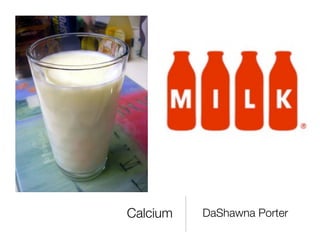Dashawn's porter
- 1. Calcium DaShawna Porter
- 3. In chemical terms, calcium is reactive and soft for a metal . It is a silvery metallic element that must be extracted by electrolysis from a fused salt like calcium chloride. Once produced, it rapidly forms a gray-white oxide and nitride coating when exposed to air. In bulk-form , the metal is somewhat difficult to ignite, more so even than magnesium chips; but, when lit, the metal burns in air with a brilliant high- intensity orange-red light.
- 4.   Number of Energy Levels: 4 First Energy Level: 2 Second Energy Level: 8 Third Energy Level: 8 Fourth Energy Level: 2
- 5. Nucleosynthesis Calcium-40 is created in extremely large and hot (over 2.5 √ó 109 K) stars, as part of the silicon-burning process in which alpha particles are added to silicon atoms. The process fuses an atom of argon and an atom of helium: 36Ar + 4He = 40Ca
- 6. Recommended adequate intake for calcium: Age Calcium (mg/day) 0–6 months 200 7–12 months 260 1–3 years 700 4–8 years 1000 9–18 years 1300 19–50 years 1000 51–70 years (male) 1000 51–70 years (female) 200 1 71+ years
- 7. Six facts about calcium 1.Calcium isn't found free in nature, but it can be purified into a soft silvery-white alkaline earth metal. 2.Calcium is the 5th most abundant element in the Earth's crust, present at a level of about 3% in the oceans and soil. 3.The element is essential for animal and plant nutrition. Calcium participates in many biochemical reactions, including building skeletal systems and moderating muscle action. 4.Vitamin D is essential for calcium absorption by the human body. Vitamin D is converted to a hormone which causes intestinal proteins responsible for calcium absorption to be produced. 5.While calcium and its compounds are not considered to be toxic, ingesting too many calcium carbonate dietary supplements or antacids can cause milk-alkali syndrome, which is associated with hypercalcemia sometimes leading to fatal renal failure. Excessive consumption would be on the order of 10 g calcium carbonate/day, though symptoms have been reported upon ingesting as little as 2.5 g calcium carbonate daily. 6.The element name "calcium" comes from the Latin word "calcis" meaning "lime".
- 8. Name Origin: Latin calx, ancient name for lime Type: Alkaline Earth Metal Neutrons: 20 Discovered: 1808 Discoverers: Isolated and identified by Sir Humphry Davy (UK).
- 9. Basic Information Name: Calcium Symbol: Ca Atomic Number: 20 Atomic Mass: 40.078 amu Melting Point: 839.0 °C (1112.15 K, 1542.2 °F) Boiling Point: 1484.0 °C (1757.15 K, 2703.2 °F) Number of Protons/Electrons: 20 Number of Neutrons: 20 Classification: Alkaline Earth Crystal Structure: Cubic Density @ 293 K: 1.55 g/cm3











